Abstract
In an environment of fierce competition, a shrinking number of customers, declining revenue, and the adverse effects of the global economic recession, the HR department play the significant role of defining the policies to adopt and the strategic direction to follow. Policy changes were the best practises of optimising HR services within the aviation industry and other international aviation organizations, which reflect the strategic direction and policy changes that were deployed during the 2008 to overcome recession.
The best HR practises defined in the HR roles for performance improvement of the aviation organizations based on the directory of best practises were applied to overcome recession. Revising the organizational structures, defining new approaches of implementing the recruitment and selection processes, identifying the rightly qualified employees among other measures besides ensuring to use the best practises could optimise the performance of aviation organization. However, adopting the changes could require clear policy directions.
Background and Objectives
Recession is an economic monster that has had far reaching financial and human resource management implications that has compelled for the readjustments of HR policies in the UAE aviation industry. For instance, the aviation industry looked to the HR department for a raft off measures to counter the effects of the economic recession such as downsizing employees by introducing new changes in in the hiring, firing, and recruitment policies.
Akbar, Németh and Niemeier (2014) note that with economic uncertainties affected the financial performance of the aviation industry, which called for the critical intervention of the human resource management to adopt new changes in planning to accurately predict the required workforce besides redesigning the work systems by introducing measures such as employee training and development, and instituting employee layoffs among other functions. Despite the resistance to change and fear of losing jobs as experienced with the human resources, new practises emerged for optimising the HR services for better organizational planning (Low & Lee 2014).
A paradigm shift in reorganizing the human resource practises that define better employee capabilities in dealing with the myriad of changes introduced into the organization due to recession. Bryman and Bell (2015) argue that the scenario led to the adoption of new strategic directions by the company in ensuring workforce stability and employee satisfaction while working in such a precariously demanding environment.
In an endeavor to establish the right strategy and path to follow, Desai, Siddique and Yaseen (2014) suggest the general paradigm in policy changes that defines the operations of the organization for optimal performance including establishing the practises that HR managers perform such as hiring the right people and creating the right methods of laying off employees to avoid a redundant workforce.
Desai, Siddique and Yaseen (2014) do not base the analysis on a specific company, but use data from different sources to reinforce the academic findings. Desai, Siddique and Yaseen (2014) make conclude the study based on empirical facts such as the need for competency based practises which include employee selection, performance management, recruitment, and determination of the employability of the prospective applicant that underpin specific contributions to the performance of the organization. Here, the study comprised of a clear set of objectives to address the problems that develop policy implications on the approaches used in optimising the HR services for better organizational performance.
Objectives
- To identify HR practices within aviation organizations
- To describe HR changes deployed during 2008 recession.
- To investigate the effect of recession on HR in the aviation organizations.
- To highlight the role of HR in improving the Organisational performance in the aviation sector.
- To create a directory of HR best practices to overcome recession.
Research questions
- What are HR practices done in the aviation organizations?
- Which changes were deployed during 2008 recession?
- What are the effects of recession on HR in the aviation organizations?
- What are the roles of HR in improving the Organisational performance in the aviation sector?
- What are the elements of the directory of HR best practices to overcome recession?
Literature Review
Introduction
A summary of the literature review provides a detailed discourse of the sources that were used in the study including the key terms that were used such as Desai, Siddique and Yaseen (2014) who present a detailed review of HR practises during recession such as performance appraisal with Low and Lee (2014) arguing on the policies to adopt during such changes. Bryman and Bell (2015) constitute the most recent authors referenced in the study besides Rabasso, Briars and Rabasso (2015) who show strategic directions adopted in the recruitment processes and the basis of developing the job description for high performing employees.
Chang, Park, Jeong and Lee (2014) suggest the policy changes and implications on different aspects of HR services and practises during recession despite failing to address the issues that arise when such changes happen. The other authors who provide additional and very strong arguments for policy changes include Desai, Siddique and Yaseen (2014), Randeree (2009), Schlumberger (2009), Stephens Balakrishnan (2011), Chang, Park, Jeong and Lee (2014), Gittell, von Nordenflycht, Kochan, McKersie and Bamber (2009), and Iles, Almhedie and Baruch (2012) despite the failure to address a vagary of issues due to the weaknesses in the research methods and prevailing business environment that is not a complete image of the recession and its effects.
However, Parakandi and Behery (2016) provide detailed exposition of actions and counter actions that could be adopted during recession and the measures to adopt in either reverting to the old HR methods or retaining the HR practises adopted during recession. The key terms used in the literature search include human resource practises, recession, recruitment, selection, job description, appraisal, and aviation employees.
HR practices within aviation organizations
A discourse of the HR practises within aviation industry reveal the crucial nature and relevance in addressing human resource issues that emerged in the UAE’s aviation industry operating in an environment characteristically defined by great economic uncertainties due to recession. A detailed study by Desai, Siddique and Yaseen (2014) despite some serious weaknesses in the methodology used to complete the conclusions which reveal that the optimal utilisations of the aviation industry’s HR management services with policy changes at all levels of the organization underpin the organization’s performance benefits.
Evidence shows that the adoption of policy changes were the results of organizational efficiency that were defined to improve performance for better service quality and lower customer referrals. Desai, Siddique and Yaseen (2014) note that the underlying driver of the best HR management practises in the aviation sector are consistent with the strategic HR management.
Employee Wellbeing
Safety, occupational health, and counselling services underpin the strategies incorporated into the Emirates airline’s HR management functions to ensure more employee efforts are put into the organization. Parakandi and Behery (2016) argue that employee wellbeing is incorporated into the organization to ensure emotional, psychological, and health promotion as products of the well-being program. Employees readily accept such programs because they are designed to address individual needs.
Driving superior performance
Typical of the HR services include motivating superior performance by divulging what employees need and what is defined as superior, determining compensation changes, encouraging counselling and coaching, and setting and measuring performance goals. In practise, Iles, Almhedie and Baruch (2012) argue that such services include establishing training and development programs to improve the overall organizational performance, establishing a framework for making decision on who and what to hire, and determining the organizational development and training needs. Randeree (2009) propose a policy adoption of the integration aggregate elements into the HR management system defines the elements of the performance appraisal system that makes it an effective tool for driving performance upwards.
Learning & Development
Randeree (2009) defines the learning and planning function as critical in the Emirates HR management services that Emirates HR managers perform with the aim of determining the risks and aligning them with the organizational human resource needs to drive the organization towards the predetermined goals and objectives. Parakandi and Behery (2016) note the basis of the HR learning and development can be implemented using the planning function, which defines the outcomes that the aviation industry has experienced in terms of better productivity, skills development among the employees, less supervision of employees, increased job satisfaction. The approach has policy implications both when operating in the period of recession and when not in recession.
Coaching
Employees readily accept the use of coaching as a tool for aviation industry HR service providers with a view of developing the right approaches to ensure effective human resource performance. Low and Lee (2014) views coaching as a tool that can be used through the use of an effective communication platform that enables the leadership to understand task requirements and the required training and development needs, guaranteeing a policy review on what should be adopted in the event of rapid changes in the business environment and human resource needs.
Performance appraisal
One element that provides the strategic direction that defines the practise adopted by the HR services in the aviation industry in the UAE is performance appraisal as a prerequisite tool for identifying high quality performing employees. Desai, Siddique and Yaseen (2014) argue that performance appraisal is applicable at the time of recession and after recession, but underscore its importance due to the challenges that happened due to recession.
However, the negative feelings elicited by the introduction of performance appraisal during recession resulted in the views that it was designed to victimise employees and lay off some of them. However, the interventional measure has proved to have positive implication both on the performance of employees due to the intervention of the HR managers in explaining the role of performance appraisal. Desai, Siddique and Yaseen (2014) argue that HR managers encourage employees to perform using appropriate reward systems to identify areas of motivation.
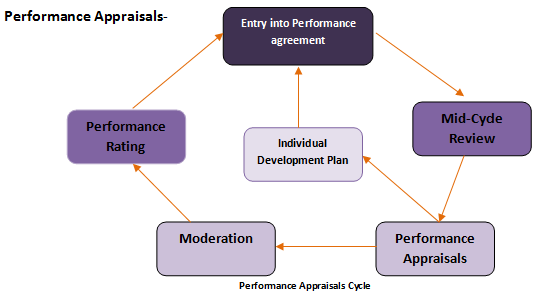
Low and Lee (2014) define policy changes that provide positive responses to the dynamism of innovation, financial soundness, long term investment, quality management, global competitiveness, and better quality services.
Performance appraisal system
According to Parakandi and Behery (2016), designing and implementing the performance appraisal systems based on the crucial functions of the HR department that the aviation industry looked into in aligning employees with the organizational performance objectives. While the employees were slow at adopting the method, it was the crucial intervention of the HR managers to address employees in accepting the performance appraisal system (Low & Lee 2014).
Underpinning the performance objectives are the job behaviours that depict how well employees are conversant with the job besides other elements that define the abilities of the employee such as planning and organizing work, ability to analyse job related problems, work initiation abilities, and comprehensive knowledge about the job. However, Bryman and Bell (2015) note that the system is designed to allow the line mangers to appraise employees.
HR practises are defined by the HR manager’s roles which include planning where managers jointly set goals that should be achieved by the aviation industry employees, designing performance reviews that reflect the organizational objectives, developing performance review schedule, and suggesting job description updates in response to the company goals and business objectives.
The most widely applied performance appraisal system is the 360 degree method that revolves about feedbacks on individual performance and consistence with the organizational goals. Appraisal is on on-going process that is done on different levels such as peers, line managers, and others within the system to address various human related issues (Parakandi & Behery 2016). The company uses the appraisal system to identify areas of weaknesses and how best to establish individual training and development needs besides assessing employees’ performance, and address business planning needs, reorganize staff, and determine career development needs (Parakandi & Behery 2016).
Evidence shows that the company uses the performance appraisal system as a requisite to comparing individual performance with organizational objectives, career planning, job analysis, job description, performance reviews, and plans for future employee development. Consistent with the appraisal system requirements has been radical achievements in designing better employee motivation, behaviour, and attitude development, effective communication, and establishment of positive relationships among the staff members.
Employee motivation
Among the best practises and services that fall within the jurisprudence of the HR management function for optimisation during economic recession is employee motivation. Low and Lee (2014) argue that motivation correlates strongly with performance as a critical function in the aviation organizations. In practise, Low and Lee (2014) note that the aviation industry has a wide range of motivational strategies inclusive of annual leaves for a minimum of 30 calendar days besides10 public holidays. The other methods used to motivate employees include end of service gratuity that are consistent with the labour laws calculated at 21 days basic salary extending for a span of 5 years besides providing a 30 days salary for the next 5 years.
In theory, motivation entails a revision of workplace design related issues that have positive impacts on the performance of the employees. Here, the power of the HR manager is clearly demonstrated in the job design that appropriately addresses the contents, methods, and relationship that fulfil the organizational purpose. The skill of the HR manager is an indicator that drives the organization to improve organizational performance in the fulfilment of the business objectives. Bryman and Bell (2015) present an exposition of the job design theories link employee motivation, job commitment and satisfaction, turnover, and absenteeism with the job design.
The basis is on the a myriad of activities which translate into organizational performance outcomes are generalised in the context of customer satisfaction, revenue generation, and quality services that depend on the motivational strategies used by the HR managers. It is crucial to note that the outcomes of motivation reflect the successful achievement of not only the business objectives of the aviation organization, but underpins the best optimisation practises on constrained resources, the result of which have been the results of recession and its impact on the financial performance of the aviation organizations.
This resonates well with the classical motivational theories of Maslow among others that identify the individual needs categorised into physiological and safety needs that are constituted in the paradigm of the lower levels of human needs (Low & Lee 2014). Here, the human resource services resonate well with the desired customer satisfaction and the quality of services available to the customers. On the basis of the foregoing review, the Emirates provide a strong case of the HRM motivational strategies applied on employees.
Employee engagement
The outcome of employee engagement is illustrated in the key performance indicators that revolve around employee satisfaction, reduced number of absenteeism from work, increase in production and profitability and in performing work related tasks. The policy change was in line with the new policies formulated to respond to the changes in the business environment despite the approaches being classical in nature.
However, the adaption was based on revised models that enabled effective employee engagement, which was viewed as a HR practise that is embedded into the actions embodied in maintaining and streamlining job roles while ensuring adequate staffing was done within the Emirates organization. According to Gittell, von Nordenflycht, Kochan, McKersie and Bamber (2009), it consistent with the strategic HRM and resource based theory where employees are viewed as a source of competitive advantage and where the HR practises are viewed as having direct impact on different ways of manipulating the human capital of a firm.
Based on the classical HRM arguments that have evolved into the modern perspectives of the HRM practises, the HRM function resides in the facilitation of the development and successful implementation of high performance work practises that are reflected in the job design, talent management, recruitment and selection, skills development, employee empowerment, and rewards. According to Stephens Balakrishnan (2011), it is evident that the elements have generally been designed by the HRM managers of the Dubai Airports – Emirates Airlines – Air Arabia companies. Here, the HRM practise evolves into the clear vision and set of values embedded in the big organizational ideas.
Wage adjustment
The overall wage adjustment during recession can either be upwards to keep a smaller number of employees who do more work with better efficiencies and effectiveness. Wage adjustment is viewed as a practise that positively responds to the dismal financial performance of the organization. The HR managers in the aviation industry make decisions on the strategic methods of adjusting wages and the size of the work force in line with their qualifications, experience and productivity.
A discourse of the wage adjustment practises by Desai, Siddique and Yaseen (2014) show that the practise leads to freezing of the wage structures, limiting overtime bonuses, and reducing entry level wages. That is despite the likelihood of companies in the aviation industry losing talented employees. To ensure the loss of talent does not plague the company, wage freeze can be applied to fixed costs to keep them constant as a radical change within the aviation industry and an important HR management practise.
That is consistent with the study by Bryman and Bell (2015) which observe consistence with practical requirements of keeping the workforce stabilisation and requirements that underpin effective HR management practises in the recession period within the aviation industry in the UAE. Stabilisation entails replacement, redeployment, optimisation of employee training programs, careful use of lay-offs, use of sabbatical leaves, and employee relocation (Stephens Balakrishnan 2011).
Determination of Employability
Another practise that has wide implications on the performance of the aviation industry is the ability of the HR managers to determine the employability of a person. Easterby-Smith, Thorpe, Jackson (2012) argue that the HR management function entails assessing the fitness of an employee in the working environment to ensure productivity is achieved and redundancy is reduced besides initiating retraining programs where necessary.
Recruitment
According to Easterby-Smith, Thorpe, Jackson (2012), recruitment and selection practises do not escape the core functions of HR manager. This is consistent with the resource-based theory where the thinking of HR managers using the inside-out approach and the outside-in approach provide a new stream of thought to perform the HR tasks. Schlumberger (2009) provide a typical example of the pilots’ recruitment process that entails prospective applicants making online applications that leads the applicant to do a simulation briefing and tests before being subjected to a psychometric test after which an assessment centre is set up to perform further tests to evaluate the abilities of the applicant.
The Emirates cabin crew recruitment process is a typical example of the description of the HR practises that are defined by the necessary requirements for an applicant to fulfil one to be selected for the job. An analysis of the HR management practise here includes short listing candidates and screening them besides using the key elements of maturity, confidence, attitude, flexibility, and friendly disposition.
Easterby-Smith, Thorpe, Jackson (2012) note the effects on performance of companies within the aviation industry include a segmentation of business jurisdictions. Internal factors are conceptualised to include airlines’ budget, employee skills levels, required productivity, compliance with the laws and practises of the country and other destination countries, and the organizational structure.
Chang, Park, Jeong and Lee (2014) note the other external factors that emerge to include the technology advancements. Technology is in the context of the acquisition of new and better performing planes in its fleet which includes 270 aircrafts, including Airbus A330-200, Boeing 777-300, Boeing 777-300ER, and Airbus A380-800, which has 142 Airbus A380’s in its fleet of modern aircrafts. Other factors that have direct impact in shaping the HR management function include workforce demographics especially for the purpose of attracting high performance employees, external government regulations, and collaborations among organizations in the aviation industry.
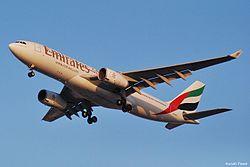
Job description
Among the practises adopted by HR managers during recession within the aviation organization is to design and develop a job description appropriate for each job. The quality and performance outcomes of employees recruited and selected depend on the human resource practise in the UAE’s aviation organizations. According to Iles, Almhedie and Baruch (2012), it underpins the job description that entails evaluation of the skills and experience of the applicant. The HRM function takes the responsibility of designing, developing, and maintaining the recruitment process in relation to the needs and business strategy of the aviation organization.
That is in addition to designing the selection matrix to optimise the recruitment sources and recruitment channels. According to Easterby-Smith, Thorpe and Jackson (2012), managers make it the habit of conducting market intelligence and surveillance activities to determine the trend in the market and ensure that the best practises are followed in the recruitment and staffing practises. One key aspect of the HRM function is to make the recruitment process cost effective in response to the punishing economic effects of recession. This is in response to the type of job to be filled and the necessary skills requirements.
It is important to note that the job description which is developed by the HR manager reflects a thorough job appraisal and its requirements for each department. Here, the quality standards speak of the necessary services and product offerings relevant to customer needs and expectations (Easterby-Smith, Thorpe & Jackson 2012). It is vital to note that aviation HR manager works on a framework that excludes the effects of age, sex, religion, and other elements that may be interpreted as discriminatory.

Measuring is a concept adopted by the done HR manager to determine the job performance whose results are documented to enable decision making on either to modify the job in relation to the job performance requirements or to adopt the concept within the aviation organization as depicted in figure 1 (Rabasso, Briars & Rabasso 2015). The HR involves others such as the boss, fellow HR managers, open positions, and others in creating an effective job description.
Determination of the quality of employees
The crucial natures of HR practises define the quality of employees in the context of skills, education, and knowledge that underpin the competence required to fulfil the job requirements for the desired performance expectations and outcomes. Schlumberger (2009) argues that the HR function is designed with the responsibility of developing appropriate recruitment plans that factors the job description, the shortlisting criteria, and the requirements necessary to conducting the interview.
Typical of the advert is where it is to be placed and who and where to do it. The recruitment function is in response to the myriad of HR challenges faced in the aviation sector that define the competitive landscape of the industry especially during the recession period. Considered as a valuable asset rather than a variable cost, employees are recruited competitively in the fulfilment of the HRM function that is consistent with the policies and practices of the UAE aviation organization (Schlumberger 2009). This is done from a pool of applicants who show interest in working for the organization who send applications for the advertised positions. Here, the industry goes for the best qualified staff in reflection with the internal human resource needs and practises and the external competitive environment in the global aviation industry.
Developing a common corporate culture
HR practises evolve into the approaches used to develop a common corporate culture as an area of commitment that defines the practises of the HRM function among the aviation organizations (Stephens Balakrishnan 2011). In practise, it is evident that the aviation industry operates in a global environment that underpins its decision to develop a strong cooperate culture that makes the workplace more productive, increase in the use of teams, upholds different cultures and nationalities, enhancement of quality services, and upholding the self-worth of employees and a sense of belonging to the organization.
In theory, a corporate culture depicts a strong relationship between organizational performance and the organizational strategy. This is evident in aviation industry especially in the time of recession want to optimise profits with the existing employees. Here, the existence of culture, strategy and performance and the optimisation of the elements contribute to the success of the business organization (Stephens Balakrishnan 2011). The development of customer centric and safety culture underpins the key element that characterises better performance of the aviation organization.
Performance management
The practise is embedded as a team driven HR management practise that is constituted with members who possess the desired skills and competence for a high performing aviation organization. According to Stephens Balakrishnan (2011), within the aviation industry, HR managers have developed a performance development program that supports senior staff to develop short term and long term plans, align people, processes, and technology with the performance expectations. In addition to enhancing employee productivity and innovation, manage multidisciplinary cross functional teams, identify and remove redundancies, and improve the ways work is executed by the employees.
According to Saksena, Saksena, Jain and Parveen (2013), aviation organizations operate in a highly competitive environment and an appropriate behaviour of the employees can be facilitated by the HRM practises that factors motivation and in seeking for solutions to employee problems when they happen. Behaviour is a central component that positively affects customer satisfaction, which is one of the driving forces of the success of the aviation organization. It is evident that a correlation between employee behaviours with the HRM practises has an ultimate effect on service quality when evaluated along the dimensions of quality.
Employee satisfaction
Other practises include devising ways of making employees to get the satisfaction needed in the context of the services delivered by the human resource management on the basis of the responses from customers that is measured on an attitudinal and indexed metrics to evaluate the degree of happiness of the customer and the employee. According to Iles, Almhedie and Baruch (2012), the level of satisfaction is measured on responses general scores that are either positive or negative. However, the critical elements of motivation plays an important role in determining the level of customer satisfaction as a HRM driven factor besides being appreciated as a personal attribute.
Besides, motivated employees have evidentially shown an inherent capacity to improve service quality which is one of the prerequisites to customer and employee satisfaction (Schlumberger 2009). HRM function endeavor to create a situation where employees work hard by optimising the personal skills and abilities to ensure complete customer satisfaction, which is one of the critical elements of the corporate culture.
HR changes deployed during 2008 recession
Policy changes were the result of the effects of the painful economic recession that underpin the raft of changes that were adopted both at the local and international levels with adverse implications on the employees’ performance at individual and organizational levels. To either adopt such measures or not in the face of the resulting challenges defined the call for the skilful intervention of the HR practises with carefully drafted measures that were integrated with accompanying measures to ensure optimal utilisation of company human resources without the adverse effects that could have ripple effects on the performance of the organization.
Recruitment changes
The aviation industry was compelled to adopt policy changes that had short time effects on the freezing of employment with the benefits of reductions in labour costs. Despite the adverse effects on the employees working as teems for the organization and the HR teams, it was equally opportunistic for the organization to adopt new recruitment practises to optimise employee inputs, which in the short term were effective but undesirable in the long term.
However, the recruitment team provided inputs on the best practises to adopt and use such as offering mandatory leaves with reduced benefits to cushion the employees against the adverse effects of recession (Rabasso, Briars & Rabasso 2015). In addition, the Emirates airline’s HR managers proposed cuts in overpay time as a measure to cap expenditure and save company revenue. In addition to the proposed measures were to solicit for cost-reduction ideas from employees that were analysed and implemented with care because of the unwelcome effects such measures could have on the employees.
However, the measures had far reaching positive and negative effects such as reduced motivation besides placing the employees in precarious positions in the organization concerning the future and that prompted measures that could cushion the remaining employees to ensure continuity at work (Rabasso, Briars & Rabasso 2015).
The rationale was that the labour market experienced a downturn with employment and unemployment being immediate and the resulting effects of the productivity of employees declining significantly.
In addition, the number of people who lost their jobs and those expecting to get jobs in the anilines industry went into oblivion. The resulting nature of the jobs’ landscape that deviated from the classical and modern approaches to human resource management practises sounded a serious warning of the loss of career jobs, lack of proper job tenure and job security, reduction in the money devoted to the human resource training and development, and resort to the use and application of non-standard and non-formal methods of job practises. The underpinning results include the disappearance of career systems and internal labour market functions and the widespread use of temporary work contracts between the employer and the employee.
Studies show that recession in its scope and extent as defined in its prolonged and depressed nature had adverse implications on the classical and modern human resource management models, practises, and the resulting industrial human resource relations. Clarity in the context of the HR practises and the impact on the HRM models and the resulting relationships in industry provide challenges on whether new and different models should be adopted or the existing models be adopted in the implementation of HR practises in industry.
Here, the HR component operates in the context of the failure to clarify the strength of the relationship between the time recession lasts and the resulting impact on the aviation organizations (Rabasso, Briars & Rabasso 2015). Here, the theories of the labour markets and the resulting HR management practises show evidence of deskilling and deterioration of industrial relations despite the general pattern of continuity of the HR practises that are evident in the aviation organization with respect to the human resource management and behaviour. This is in relation to the drastic changes that have emerged on the way the HR function is applied in the hiring and firing employees, and the need for the firms to concentrate on the core competencies.
This paradigm shift within airline organizations in the aviation industry is evident with the inclusion of the strategies in various destinations outside the United Arab Emirates (UAE). It is evident that the HR managers figured out the best methods to manage the HR functions such as identifying those practises in conjunction with the management to enable the companies and employees to work in teams.
Policy changes and effects
Here, the HR management responses to employment options served as a strong foundation for policy changes adopted and implemented by the HR managers as a practise that was defined by designing new employment methods and structural organizational changes (Rabasso, Briars & Rabasso 2015). Such approaches were helpful in the start despite requiring to be revised due to changes in the business environment. It is imperative to note that within the companies operating in the aviation industry, the policy shift met with employee resistance to changes that elicited responses from the HR managers to address the adverse effects and attitude developed among the employed due to the radical HR management changes.
However, the methods are interventional and transient in nature. In addition, the temporary nature of the swinging approach is in tandem with the classical and modern economic models that have evolved with time (Schlumberger 2009). This is in response to the labour market changes that have been caused by the global economic crisis in the form of persistent recession. The approach places a barrier in shifting the organizational risks to the employees as the external operating economic environment continuously become risky.
Among the measures were to reduce the pay packages, introduce paid and unpaid long leaves depending on the type of work, and hiring those employees as external consultants. The goal was to reduce the cost incurred and maintain the best employees while ensuring that optimal employee performance remained the objective.
High-commitment HR transformation
Among the suggested changes on the HR function is high commitment which involves focusing not only on the employee and the employer but also on the best methods to invest in the customers, line managers, stakeholders, and the community that is affected by the operations of the company (Rabasso, Briars & Rabasso 2015). Evidence from the aviation industry shows that the management involves all stakeholders including factoring employee and customer needs and expectations leading to their satisfaction due to the services provided. It is the case with other organizational in the UAE operating in the airlines industry.
The performance implications of the HR function on the basis of the professional service groups that underpin the definition of changes that have been embraced in the HR management function include better employee productivity, hope for the employee even during recession, better deployment of specialised personal, and the articulate description of new roles of employees in the recession period.
In addition, it emerged that employees within the HR management endeavoured to adopt the strategies that made them shift from the traditional approaches of using the command and controls structure that has persisted when business was booming to the establishment of high performance and commitment management (Schlumberger 2009). The new changes that were prevalent in the HR management function included positioning the airlines organizations to address the emerging challenges and impact of recession on various operations of the firms.
Here, studies on the effects of recession on the HR management function and the effects on the performance of the organization led to the conclusion widely adopted by HR managers such as the cost saving functions, reorganization of employees and those in the management hierarchy, and the overall goal of acting in the capacity of the pivotal role of the HR manager (Rabasso, Briars & Rabasso 2015). That included embedding practises such as innovation, facilitating leadership, and creativity among the employees besides attracting and maintaining talent within the organization.
To thrive, survive, and develop human resource capital capabilities was among the changes that have been adopted by the airline organizations that defined the HR management function. It enabled the organizational managers to tap into the energy inherent in trained and well skilled employees besides creating a framework to create a strong engagement of the employees within the organizations. Besides, the radical changes that have been proposed in other areas that were introduced into the airlines industry on the basis of the HR function include effective communication and the use of monetary rewards. The rationale is that it gave employees a sense of ownership of the company as evidenced in the performance improvements.
Contribution to the eclectic change in HR practice
A deepened relationship between senior management and the HR management levels were areas of change that were identified as being a crucial changes to implement. Here, the preclusion of existing HR management policies is not recognised as a change to implement. Original policies that enable a focus on the organizational strategies must be maintained and for the continued survival of the organization (Rabasso, Briars & Rabasso 2015).
This includes reviewing hiring and firing policies and procedures, designing recruitment and selection procedures that are consistent with the organization’s recruitment methods, and identifying employees with the kind of talent and high profile personnel necessary for inclusion to trigger positive organizational performance. It is imperative that recession was the key driver in the adoption of new HR management approaches to executing the HR function such as the use of in-house HRD programmes for recruitment and coaching (Schlumberger 2009). While training and development were programmes that cut across different seasons, it is important to note that the HR practises were changed into prioritizing the training and development programmes that had immediate impact on the survival of the airlines organizations.
Effect of recession on HR in the aviation organizations
There is little discourse on the literature on the effects of recession on the HR in the aviation industry. However, researchers agree that traditional HR practises and policies have remained intact making the effects of recession and adjustments to remain within the established policies governing the operations of the HR managers.
Emerging challenges due to the financial performance of the organizations are clear indicators of the themes that keep crystallizing within the HR management function that have been noted to exist in the industry such as the need to optimise human resource strengths and performance (Rabasso, Briars & Rabasso 2015). Here, the elements emerge into effects on planning strategies and methods, the review the work systems and job design (giving employees the opportunities to participate), staffing approaches, training and development, and compensation methods.
While the mentioned elements revolve around the traditionally accepted HR management functions, recession has brought new challenges and the need to focus better on new initiatives and strategic approaches of employing people to work for the organization besides cultivating the new roles of ensuring that employees put more effort on the job tasks that they are assigned to do.
Planning
In the context of the planning function, the HR management have to look for new ways of addressing the challenges that happen to avoid the problems arising and effects on the human resources and the spill over effects of downsizing that leads to the survivor’s syndrome (Schlumberger 2009). This affects the HR function in the approaches and specific ways of establishing contracts between the employees and the organization. As conceptualised in the planning function, the HR identifies high potential employees and talent gaps which differ from the classical planning function of identifying, improving, and merely utilizing the human resources within the organization by incorporating new approaches of fulfilling the HR management function.
One strategic element that has been adopted as having an effect on the HR due to recession is the introduction of fair recruitment processes and practises (Rabasso, Briars & Rabasso 2015). HR managers and academic coupled with industry researchers have noted that an effective recruitment practise is a tool that has been widely accepted for to primary reasons which include the integrated ability to identify the needs of high performance employees and the contributions they make towards the performance of the organizations. In addition, it is imperative to note that the performance of aviation organizations in the UAE depend on the contributions of the high performance employees.
One crucial element that crystalizes is the need to engage and retain high performance employees to avoid the downturn event of losing them. Loss of high performance employees is prerequisite to the inability to achieve the performance objectives and to steer the companies along their performance objectives. Examples include reorganization that requires new planning approaches to address the reorganization and restructuring of the organizations.
Work design
Despite the failure to achieve the work design during the 2008 recession, the HR policy that was adopted after 3 years was inclusive of the legal departments to address the work design challenges that happened in 2008. In principle, this involves downsizing of the employees required a reorganizing the organizational structures, the tasks and responsibilities associated with different jobs, and the nature of interrelatedness within the new job structures within the legal frameworks (Rabasso, Briars & Rabasso 2015).
The change here is to involve the clauses in law. The HR managers should show competence in the requisite job related skills and to address the skills needs that result from employees shifting to new jobs to perform their new functions properly. Job rotation plays a significant role in this case because HR managers are able to determine the right area to shift employees (Schlumberger 2009). Competent HR managers with the right t skills are invaluable in addressing the challenges that happen due to organizational restructuring in assigning the right job roles and responsibilities for the employees. Here, it is possible for the management to realise a decrease in costs besides an increase in skills enrichment for the employees.
Performance management
The best technique to ensure effective performance management is to use performance management as a strategic tool to enhance performance at the line managers and operations levels (Schlumberger 2009). Here, the HR managers find themselves compelled to redesign the performance management systems and introduce appraisal systems that are used to recognise better performers and punish poor performers, which underpinned the performance based culture. This incorporates a disciplinary process for employees who fail to strictly adhere to the appropriate timeframes with appropriate policy implications for HR managers.
Policy directions on performance management provide the strategic direction for clearly defined objectives for the aviation industry (Rabasso, Briars & Rabasso 2015). Here, the HR finds it compelling to revise the performance appraisal systems based on the downsizing and reorganization of the management and organizational structure. This scenario leads to the conclusion that HR managers need to develop appropriate focus on high potential employees, alignment of skills, redesigning of the strategic techniques of recruiting and hiring employees and training and development programs.
Role of HR in improving the Organisational performance
Different theories of human resource management approaches and organizational performance amalgamate into a single paradigm that reveals the roles HR managers play in improving organizational performance in the aviation organizations (Schlumberger 2009). However, a summary of the roles depicts a classical nature that shows some inconsistence with the operations of the organizations in the aviation industry calling for a review of specific roles that are aligned with the aviation organizations (Rabasso, Briars & Rabasso 2015).
Among the roles that have been suggested as having practical implications on the performance of aviation organizations are summarised into aligning HR management with business strategy, talent management, organizational performance management, career development, acting as a change agent, and diversity administrator.
Linking HR management with business strategy
One role that is widely viewed as critical in the aviation industry and identified as a consistent HR practise is linking business strategy with individual objectives with cooperate goals. Employees were made aware of their contributions to the attainment of higher performance levels through awareness programs of individual productivity based on underlying policies as designed by the HR managers in 2014 (Rabasso, Briars & Rabasso 2015). Here, the HR designs strategies for involving employees in identifying and addressing the challenges that happen in the aviation industry. This implies the HR determining the right expertise to operate in the aviation industry in terms consisting of a whole range of the employees in the industry ((Schlumberger 2009).
Embedding organizational culture
Besides, recession comes with several economic challenges that define the demands placed on the human resource capabilities in designing the right tools and techniques for embedding the organizational culture into the employees. Here, consistence with the values of the employees and the culture define the attitudes and nature of the behaviour shown by the employees within the organization.
As a practise and a critical role of the HR function, it is critical to understand the nature and technological skills required in the organization, additional skills required to improve the performance of the organization, and the methods and system to put in place for imparting the desired skills (Rabasso, Briars & Rabasso 2015). The entire paradigm of responsibilities and roles are included in the summary of functions that include the industrial management of the organization, personnel administration, organizational management, and manpower management.
Redesign of organizational structures
A typical example where restructuring occurred was in Dubai airports in 2015 that has achieved an 80% restructuring and still on-going consistent with the demands in the aviation industry. In theory, restructuring incorporates re-evaluation and inclusion of new programs, budget reductions, enhancement of organizational effectiveness, and changing unit priorities (Rabasso, Briars & Rabasso 2015). In addition, efficiency was based on labour relations considerations, communication, and effective methods of addressing relevant workforce to be utilised to optimise organizational performance. Design and redesign organizational structures that reflect effective working for the organization, coordinate individual employees and teams to ensure better and effective working conditions.
Talent management
HR managers work as architects to achieve high organizational performance by advocating elements such as talent management that can be optimised for better organizational performance. Dubai airports have been struggling with this element and through careful consideration defined a new department that could develop the outcome objectives for talent management. This could enable the HR managers to address rapid changes driven by recession in the aviation industry to drive performance and ensure sustainable success. Underlying the objectives is the framework designed by the HR managers to accelerate employee development, transfer knowledge and identify internal talent pool.
This was exemplified in the profiles of the vice president of the Emirates airlines who shows excellent talent in corporate leadership & talent management having worked in various areas and capacities such participating in the design of the global talent management strategy for 38 Countries and 22,000 employees (Rabasso, Briars & Rabasso 2015). Other talents include the vice president human resources-recruitment/ manager–group recruitment with many years of working experience and was nominated in 2009 for the aviation awards HR manager of the year. It is the critical role of the HR manager to retain such talents.
In practise, Low and Lee (2014) emphasized that talent management should conceptualised as a strategy for developing the skills, knowledge, and expertise of the employees as a proactive measure of responding to the human resource and business complexities that happen in the aviation industry. Here, building the people is a HR role that occurs within the organization to enable them acquire the right skills and knowledge besides putting in place structures for recognizing and keeping talent.
Putting in place systems for recognizing skills, talent, and for identifying the necessary traits for talent recognition and management underpins the HR function. Here, the HR manager ensures that the framework supports the recruitment and selection with the additional element of talent and management as a tool for better organizational performance.
The overall goal is to create a talent management program that enables aviation organizations to pool talent and adopt the right recruitment criteria to put in place actionable compensation mechanisms that are inclusive of every conceivable aspect of talent management.
Change agent
This is not only the role of the HR managers, but a cross functional role that has become crucial in the management of the affairs within the aviation industry especially when managing changes that affect the human resources across different departments. This happens especially when undergoing radical changes which affect both the employee and the image and performance of the organization (Rabasso, Briars & Rabasso 2015).
As a change agent, the HR manager performs the role of the transformation role of creating human resource management structures and systems to accommodate anticipated and unanticipated changes that happen and focusing on those elements that focus on the planning and implementation of the transformation processes. The goal is to integrate the elements that enable performance improvements and to remove the elements that lead to resistance to change.
Low and Lee (2014) argue that The HR manager plays the significant role of being the source of change in the context of the external and internal readjustments and economic environmental factors. However, the role of acting as a change agent provides the foundation for making the HR a champion of change by providing the required change management skills for the alignment of the people with the requisite knowledge and skill based changes. Here, learning as a way of life and organization development is encouraged by the HR managers as a critical role to observe.
Persuasion
According to Parakandi and Behery (2016), HR managers provide the ground for powerfully persuading employees within the aviation industry to work and persuade them to adapt to new changes in the aviation industry. It has been established that HR managers ought to understand the aspects of dynamism in the aviation industry to develop training and development programs that link employee skills with those required to operate in a new and technologically changing environment (Rabasso, Briars & Rabasso 2015). The other roles include identifying the incentives, increasing employee morale, appreciating the human assets, providing adequate compensation, providing a good communication platform for conflict resolution and information sharing, and to provide the necessary leadership for organizational transformation and better performance.
A directory of HR best practices to overcome recession
A directory of the best practises that enables HR managers to improve organizational performance on the basis of employee skills, commitment, knowledge, and skills coupled with the use of better recruitment policies and systems of employees who are organizational assets to overcome recession have emerged as depicted in the literature review. Experience, performance appraisal, motivation, employee engagement, wage adjustments, employability, recruitment, determination of employee quality, corporate culture, and performance management. That is besides the other elements which include employee satisfaction, employee selection best practise, and relevant job description.
However, radical changes that were observed to happen and that could be a relevant element to factor into the repository include the wide range of commitments from the HR manager to eclectic changes. However, organizational structures to make them lean is another element factor, use of communication in its scope, revision of bonuses, employee lending, use of exit incentives, and encouraging voluntary leaves.
Research Plan
This research was designed to investigate the optimization of HR services during recession in the aviation industry in the UAE. An evaluation of different research methodologies and techniques based on the research objectives provided the criteria for decision making on the use of both the qualitative and quantitative research paradigms. The objectives reflect the qualitative and quantitative nature by broadening the avenue to pursue in collecting the right data for analysis and in making the right conclusions. In the literature review, relevant concepts were utilised based on the objectives which were consistent with the research problem and the purpose of the reach which was to determine how best to utilise the human services in the aviation industry.
Research design
On the basis on the qualitative paradigm, interviews were administered on the respondents as the primary sources of data. Besides the usual advantages, rigour, and practise associated with conducting interviews, the method was critically reviewed for consistence with the research objectives on the basis of the philosophical discourse of interviews. The interview questions were developed in accordance with the philosophical foundations that are defined in the context of reflexivity grounded on interaction and relational dynamics with the respondents.
On the context of the quantitative paradigm and because of limited time to conduct the research besides the need to establish the most reliable data collection methods to generate valid data, a series of sampling techniques were evaluated for use. The techniques included deliberate sampling, systematic sampling, simple random sampling, quota sampling, sequential sampling, multistage sampling, cluster, and stratified sampling techniques on the basis of the best technique to yield solid and empirical facts to answer the research questions.
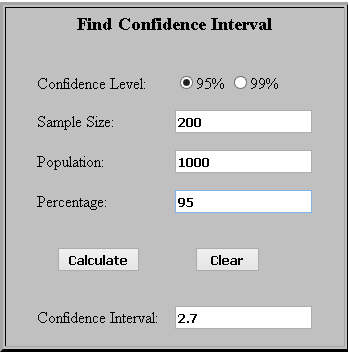
The rationale was to optimise the responses that were fairly distributed across the respondents’ strata that were defined by non-overlapping groups of airline employees including HR managers and employees from different departments. In addition, no sampling frame was required because of the cost advantage, and the efficiency associated with the data collection method.
Here, the target population include the human resource managers and other employees at different levels of management working for the aviation industry. The basis for calculating the sample size was based on the following formula:
![]()
The number of employees within the company is 84,153 from 160 nationalities and the number of staff in the UAE’ working for aviation industry is 11,000. Using software, it was easy to calculate the sample size. However, to ensure that the results were valid, the confidence interval and levels were first determined. The confidence level consisted of the margin of error that confined the results within the desired accuracy.
The confidence interval is the degree of uncertainty associated with a sample statistic based on a confidence level of 95%. In this case, the margin of error was kept as low as possible which are characteristically critical values which are characterised by a normal distribution to ensure that the results were within the 95% confidence interval with a significance level of 0.05 and confidence interval of 2.7 as shown in figure 4.
On the other hand, it was a prerequisite to ensure that the confidence level was appropriate when expressed as a percentage to ensure that true percentage of the population provided reliable responses. In addition, the sample size, population size, and percentage confidence levels were factors attributed to the resulting validity and reliability of the findings. Here, a 95% confidence interval was used.
Reliability
The research results were tested for reliability data selection tool was evaluated using a Cronbach’s Alpha (α) of 0.8 using a small sample of 20 respondents. Using a Likert psychometric scale, each item of the questionnaire was evaluated to determine the level of reliability. When tested, the results showed a value of 0.835 which showed evidence of strong reliability on the items in the questionnaire.
Table 1: Reliability statistics.
Table 2: Reliability test.
The reliability test that was conducted on the questionnaires based on a statistical analysis of the responses from the 20 participants yielded a Cronbach’s Alpha with a value that was more than 0.80, making the results reliable based on a single test questionnaire.
Content validity
An investigation of the validity of content was done by involving well versed people on the full domain of content from different departments on the objectives of the study and consistent with the interview data collection methods. The reliabilities of the interview results were evaluated for consistence with the research concepts and indicators for measuring the elements that were discovered in the research. The removal of random errors was contextualized in the degree of the allowable extent to which the results could alter the dependability of the findings. However, the sources of errors could not be enumerated despite interviews being an integral part of the validity of interviews.
Data collection procedure
Both interviews and questionnaires were used to collect qualitative and quantitative data using the following steps.
Interviews
The interview setting consisted of the interviewee and the interviewer who consisted of three HR managers, employees of the aviation industry who made positive contributions as inputs into the aviation organization during the recession period. Different areas of investigation were discussed as the results were tabulated and transcribed by skilled people because of time constraints.
Questionnaires
Questionnaires were issued to 200 people after a test of validity had been conducted and analysed showing a Cronbach’s Alpha of more than 0.80 where the required value is 0.800 for reliability.
Data analysis
The data was subjected to statistical analysis using the SPSS software to determine different values inclusive of the Cronbach’s Alpha, significance values, the t-test statistic, and correlational tests each with different implications on the findings. To establish the association between the organizational performance and the HR practised during recession, a correlational statistical test was done. However, the strength of the relationships between the tests were based on the Pearson correlation coefficient with the aim of determining the effects of the contributions of the HR managers in creating strictures that enhance employee performance during recession in the aviation industry in the UAE.
Data Collection, Presentation, Analysis and Findings

Illustrated on table 2 are the respondents by gender and consist of 39% female and 61 male of the selected sample working in the aviation industry.
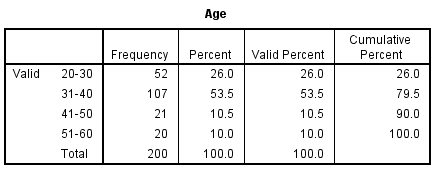
Table 2 shows the age of the respondents according to the age brackets that have an Employees aged between 20 and 30 working in the aviation industry constitute 26%, ages between 31 and 40 were 53.5%,whch was the highest, ages between 41 and 50 were 10.5% and those aged between 51 and 60 were 10%. The rationale for establishing the age is to generate data that correlates well with the experience and the contributions of employees to the performance of the organization.

Table 3 is an illustration of the varying experiences that the respondents have who have worked in the aviation industry. Experience varies between 70%, which is the highest percentage and 5%, which is the lowest. It is evident that over 58% of the respondents have a long term experience working for the aviation industry. HR managers should identify those employees with the right experience and device methods of retaining them to reduce employee turnover.

Table 4 provides a detailed descriptive statistics of the different elements that define the implications of the HR practises in the aviation industry with special. The rest of the data is in the appendix HR practises that can be optimised to improve the performance of the aviation organizations in the period of recession. The entire table depicts a skewness that varies in the range between statistical values of 0.098 for experience to 11.69 for voluntary leaves. The skewness is a demonstration of how the HR services can be optimised to improve organizational performance depending on the weight of each specific element in the optimization paradigm.
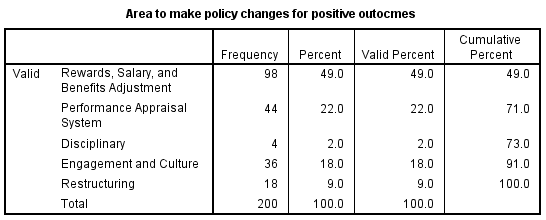
Ploicy chnages are the core elements that define the strategic direction aviation industries take to address the adverse effects of recession. However, such changes must receiprocate with a cleatr identification for the need to change the policies, the specific areas of policy changes, and the policy implementation at various levels of the organization. It is evident from table 5 that the areas of policy change that could have positive outcomes include adjustments on rewards, salary, and benefits, which consitute 49%.
It is imeprative to note thatr salary adjustmentc an be downwars if no layoffs are considered or can be upwards to reduce the number of employees and optimise performance. the HR managmet should take the prerogative of evaluating either options to select the most appropriate. Observations on table 5 shows that the outcomes are distributed in relation to percentage responses to using of performance appraisal systems constituting 22%, taking disciplinary measures constitutes only 2%, use of high employee engagement methods constitutes 18% while restructuring received an 18% positive response.

Performance appraisal is a system used in the aviation industry to ensure positive achievements at optimal levels during recession. It underpins strong performance accomplishments and excellence task execution at different levels of the employee performance. The response to performance appraisal as a critical practice for optimizing HR services during recession in the aviation industry received responses showing that 45.5% strongly agreeing while 48.5% agreeing with the position.
It was only 6% neither agreeing nor disagreeing and that underscores the importance of performance appraisal as a tool for Performance appraisal is a practise the enables the HR manager to determine employee are most suited for particular jobs and to remove redundant employees without the requisite competencies and skills to perform job duties. Typically, performance appraisal can be achieved by the HR as a best practise to address HR issues related to performance through better administration, coaching, cooperation, creativity and innovation, effective communication, delegating duties and responsibilities, and use of effective problem solving methods.
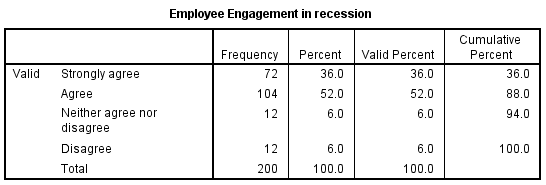
Engagement is a typical tool for optimising the HR services during recession for better productivity in the aviation organization. It can be observed from table 7 that respondents who agree that engagement leads to better employee performance is based on 36% while those who agree include 52% on the employee engagement and 6% neither agree nor disagree and 6% disagree.
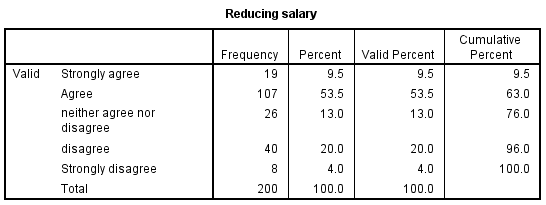
Reducing salaries is considered as one strategy for improving the HR services during recession in the aviation industry with 9.5% strongly agreeing with the idea, 53.5% agreeing, 13% neither agreed nor disagreed with the idea, 20% did not agree and 4% strongly disagreed with the idea. The question can be answered in the affirmative that HR managers should adopt reducing salary and benefits as an option to optimize the company’s financial status during recession.
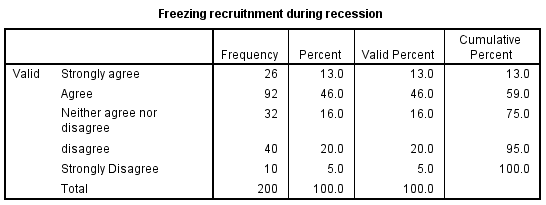
Freezing employment is a strong business case and crucial strategy company’s use during recession to reduce redundancy and direct and indirect costs in the aviation industry. The responses are illustrated in table 9. Freezing recruitment addresses redundancy problems and the problem of temporary recruitment using techniques such as natural wastage to ensure that no replacements are made when employees leave the employment.
An observation of table 9 shows that 13% of the respondents agree with the freezing of recruitment as an essential HR practise that has strong performance implications on the performance of the organization. Only 14.5% who disagree with the position of recruitment as an important HR service that can be optimised for organisational performance during recession. The type of people, qualifications, experience, and the recruitment process and practise is important for organizational performance.
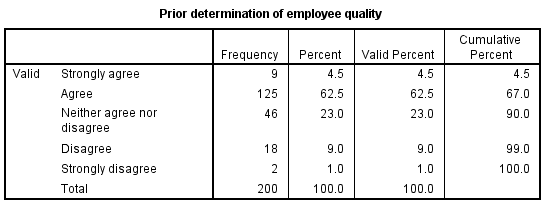
The question on if prior determination of employee quality underpin one of the best HR practices in the aviation industry was answered with 4.5% strongly agreeing with the idea, 62.5% agreeing while 23% neither agreeing nr disagreeing, 9% disagreeing, and 1% strongly disagreeing. The overall argument is that 67% agreed that prior determination of employee quality was a prerequisite for optimal work performance.
This is evident in the assertion that prior determination of employee quality underpins one of the best HR practices in the aviation industry. Those who agree with the idea constituted those that perform as per the laid down standards and sometimes exceed the standards. According to the results in table 10, those who strongly agreed with prior quality assessment made 4.5% of the respondents while those who agreed constituted 62.5%. The overall percentage of those who agreed made 67% of the respondents. Those who neither agreed nor disagreed were 23% and those who disagreed or strongly disagreed made an aggregate of 10%.
The results indicate a strong positive trend among those who agree that prior determination of employee quality was a critical human resource practise that HR managers could adopt for better organizational performance. The HR should assess the skills set and the attributes desired that define a high quality employee. In principle attributes such as good communication practises and abilities, self-motivation, good professional ethics, polite, giving credit where it is worth, productive, and identifies and implements steps to enhance output within the aviation industry. The other elements that might be considered by the HR during recession include discipline and punctuality and those who are able to turn challenges into opportunities.
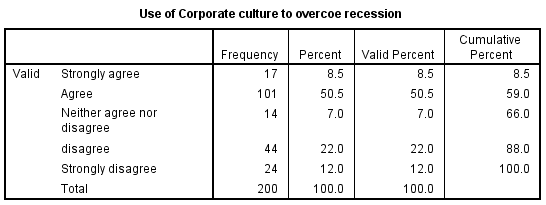
Cooperate culture is an indispensable component that defines employee behaviour within the aviation industry and defines the core company practises and ideologies that underpin employee performance. A good cooperate culture defines the impression of values and methods that drive employees to give the utmost contribution to performance in the aviation industry. It is worth noting that 8.5% in table 11 strongly agree that culture to be a crucial tool for overcoming the effects of recession in the aviation industry. However, 50.5% agree to the idea making an aggregate percentage of 59%. On the other hand, 7% neither agree nor disagree with the criticality of corporate culture while 22% disagree and 12% strongly disagree making an aggregate of those who disagree to be 34%.
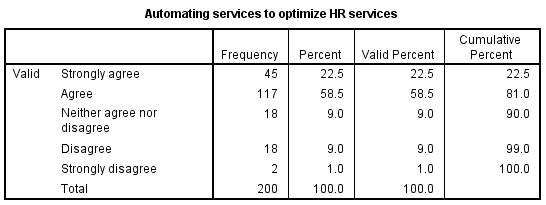
To better manage HR service relationships using automated services to enable shared services within the aviation industry and across multiple business units in the industry, the respondents were asked to provide their perceptions on automation. The results are exemplified in table 12 where22.5% of the respondents strongly agreed with the statement and 58.5% noted that they agreed with the position.
An aggregate percentage of 81% agreed with the statement and 9% neither agree nor disagree, 9% disagreed, and 1% strongly disagreed with the statement. Automating services is the modern trend that has been adopted by different companies in the aviation industry because it provides the platform for identifying and reaching a wide audience of talented people while enabling recruitment and compensation practises.
The results are usually better feedback, enhancing organizational strength, organizational alignments, and cost savings during recession. The aim of automating services is to enhance service delivery in the aviation industry during recession. In principle, automation enables employees working in the aviation industry to be more efficient, effective, and increase business value. That is besides improving employee visibility and ensuring timely and quality service delivery to the customers. Automation improves HR decision making and increases HR responses and better HR service delivery.
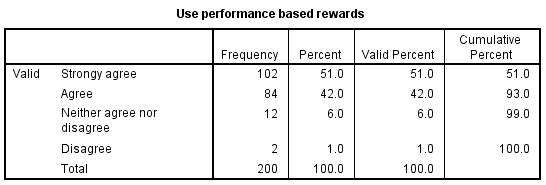
According to the results in table 13, 51% of the respondents strongly agreed that using performance based rewards could enhance HR services in the aviation industry. The results show that 42% agreed with the statement making an aggregate of 93% while 6% noted that they neither agreed nor disagreed and 1% disagreed with the statement. Performance based rewards encompass performance based payments, merits pay, and the contextual factors such as motivation that are applicable in the aviation industry for the HR function to successfully drive the aviation industry to success during recession.
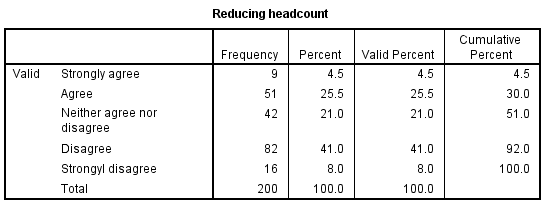
Table 14 shows that 4.5% of the respondents strongly agree that reducing headcounts define one of the best practises for HR during recession, while 25.5% agree making an aggregate of 30% for those who agree with the statement. The results show that 21% of the respondents neither agree nor disagree and 41% disagree while 8% strongly disagree making an aggregate of 49% for those who disagree, which is a significant percentage. The implication is that reducing the number of employees is not a good practise during recession.
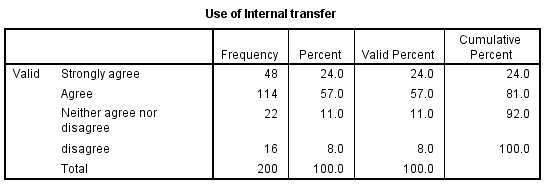
Table 15 shows that 24% strongly agree on the use of internal transfers while 57% agree making an aggregate percentage of those who agree to be 81. For those who neither agree nor disagree, the percentage response was 11 and those who disagreed were 8% of the respondents. The concept on internal transfer is equivalent to redistributing the employees to balance them and reduce redundancy in addition to applying transfers as a job rotation mechanism with its benefits for the aviation industry. The goal is to optimise existing employees during recession as a HR strategy.

Prior determination of employee quality received a 32% response from those who strongly agree, 19% who agree, 10.5% neither agree nor disagree, 27% disagree and 11.55 strongly disagree. The aggregate percentage of those who disagree is 42%, which has significant effects on the determining the quality of employees.
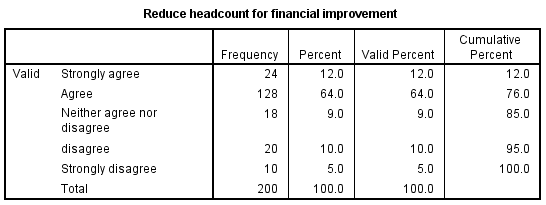
According to the results shown in table 19, the reducing headcount is a best practise that can be adopted by HR managers during recession in the aviation industry. The results show that 12% strongly agree while 64% agree making an aggregate 76%. This is a significant percentage and implementing the method reduces redundant employees which lead to cost savings and increased productivity. The HR managers in the aviation industry design the right methods to reduce the headcount without impacting negatively on those employees who remain in the industry.
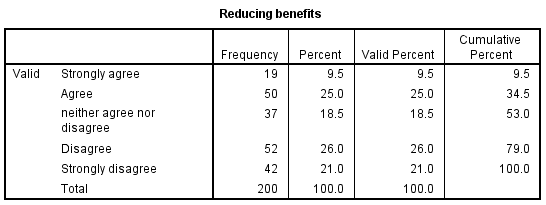
A test to determine the effects of reducing benefits as an option to optimize the company’s financial status during recession are shown in table 20. The results shows that 9.5% of the respondents strongly agree while 25% agree, making an aggregate 34.5%. However, those who neither agree nor disagree consist of 18.5% while those who disagree constitute 20% and those who strongly disagree constitute 21%. The rationale is that non-wage portion of compensation for employees in the aviation industry constitutes a significant portion of fringe benefits. However, to adjusting the benefits downwards should be done carefully by the HR to avoid a backlash and any negative effects on motivation and productivity.
Interview responses
Interviewer: Which practises do you find that are vital to optimise as a HR service for better organisational performance during recession in your company?
Manager 1:
- Employee Engagement , Corporate Culture , Performance and Business Partner Modelling
Manager 2:
- Restructure (People / Processes / Systems) to control the Cost and improve efficiency.
Could you kindly explain your observations on the effects of recession on HR practises in the aviation industry when recession set in 2008?
Manager 1:
- We proceeded with restructure for major departments, however we couldn’t achieve the target due to some hitches in the policy.
Interviewer: Which elements have you identified to be most important to include the directory of service that is essential for HR managers to put into practise if recession happens again?
Manager 1:
- Review of HR policy in combination with legal, to cover all elements related to reducing headcounts.
- Planning and Budgeting, be ready with your data and options for any future anonymous incident.
- Performance based rewards, when the ship will sink the best swimmers will leave first, and we have to retain all top performers.
Conclusion
An investigation on how to optimize HR services during recession in the Aviation Industry in the Middle East was conducted to determine the policy changes and related implications that could be adopted during recession. The policy changes during recession have been deemed to have adverse implication on employee perceptions about the tenure in the organization if the changes remain to be long term instead of being short term.
However, redeploying the employee who undergone the psychological effects due to layoffs and other readjustments presents additional challengs that the HR managers have to address. It is however imperative to note that such changes should not be long term but should be subjected to changes as changes occur in the business environment in the aviation industry. Managers find themselves in a dilemma on what measures to put in place to optimise performance as organizational resources such as profits and human resources keep on dwindling because of a harsh business environment that is characterised by fierce competition.
The HR services which demonstrate results that have implications on the HR practises which underpin an increase in the number of customers plying the aviation industry. The practises that crystallize in the study include performance appraisal, use of motivation, better techniques of engaging with employees, wage adjustments, assessment of the employability of prospective employees, changes in the recruitment practises, use of best methods for the determination of quality of employees, development of a corporate culture, and performance management methods that are consistent with the HR practises during recession.
It is imperative for the HR manager to develop frameworks for employee satisfaction and jobs description during recession because of the work related challenges that happen and which do not usually occur when the economic environment is out of recession.
It was noted in the studies that during the 2008 recession, several measures that define new policy changes were introduced that affected the HR services. The effects were demonstrated in the tables where respondents agreed that such changes were necessary in the short term despite the adverse effects of dissatisfaction and fear that reigned in the minds of the employees to align the HR services with the organizational mission and vision statements. The key changes include the high commitments for organizational transformations, eclectic changes in the HR practises that could broaden into the improvement of organizational performance.
It can be noted that the recession had a significant impact on the performance of the organization and the need for the HR managers to readjust to the practises that could lead to better organizational performance due to recession. Among the changes noted was the revision of organizational structures to improve the efficiency of each department, inclusion of better planning methods, an enhancement of work design to optimise the employees and using persuasion as a tactic to improve employee performance. The other elements discovered include HR acting as a change agent, managing of talents, embedding organizational culture among the employees, and linking business strategy with organizational performance.
A directory of services constituting the elements that provide the strategic direction for optimising HR services constitutes a wide range of suggestions that have positive implications on the performance of the Emirates organization. The key suggestions that have policy implication during recession include effective communication, revision of bonuses, provision of exit incentives, employee lending, encouraging employees to ask for voluntary leave, adjustments of the organizational structure for optimal management, freezing hiring, salary freeze, and reducing the time spent at the place of work by the employees.
Recommendations
The results from this study based on empirical evidence provide the policy directions that organizational managers need to adopt as measures of keeping afloat organizations doing business in the aviation industry when faced with the adverse effects of recession such as fierce competition, a decrease in the number of customers, decreasing profits, employee redundancies, skills gaps, and better performance demands. The results emerge into a paradigm shift that could be mandatory to adopt to improve organizational performance by integrating clearly defined practises for optimising HR services better organizational performance.
Some key areas of change for minimizing costs include revising the recruitment practises, workforce planning, training and development of employees, integration of performance management systems and appraisal, and a stop of the recruitment in case the company does not need new employees. Other areas of policy changes that give the strategic direction to pursue include organizational restructuring and revision of hiring practises, employee layoffs, and use of effective communication methods.
Appendix I
This is an investigation on optimizing HR services during recession in the Aviation Industry in the UAE. The responses will be treated as private and confidential not unless disclosure is requested for by the respondent. Please answer the questions to the best of your knowledge and in case f a problem, try to seek for classification.
- What is your age…………….
- What is your gender? Tick as appropriate Male……….Female………..
- 3. How many years of experience do you have working in the aviation industry?
- 4. Which area do you think needs to make policy changes for positive outcomes in HR practices to improve organizational efficiency during recession?
- 5. Performance appraisal is a critical practice for optimizing HR services during recession in the aviation industry.
- 6. Employee Engagement is one of the critical Practices during recession
- 7. Automating services and enhancing processes an important practice for optimizing HR services during recession.
- 8. Performance based reward can be used to achieve better organizational performance.
- 9. Reducing headcount is the best HR practice during recession to improve organizational performance.
- 10. Internal transfer is one of the best practices that can be adopted for improving performance within the aviation industry during recession?
- 11. Should recruitment go on freeze during recession?
- 12. Does prior determination of employee quality underpin one of the best HR practices in the aviation industry?
- 13. Does prior determination of employee quality underpin one of the best HR practices in the aviation industry?
- 14. Corporate culture is a tool used to overcome the recession period.
- 15. HR managers should adopt reducing headcount as an option to optimise the company’s financial status during recession
- 16. HR managers should adopt reducing salary and benefits as an option to optimize the company’s financial status during recession.
Appendix II
Statistical output data
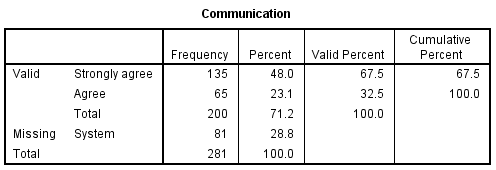
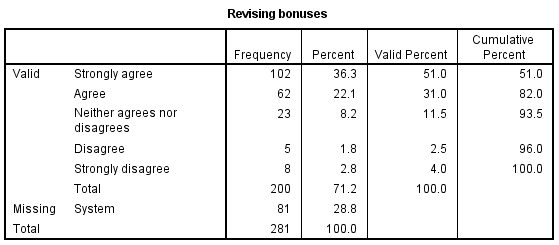


References
Akbar, Y, Németh, A & Niemeier, H M 2014, ‘Here we go again… the Permanently Failing Organization: An application to the airline industry in Eastern Europe’, Journal of Air Transport Management, vol. 1, no. 35, pp. 1-11.
Bryman, A & Bell, E 2015, Business research methods, Oxford University Press, New York.
Chang, Y T, Park, H S., Jeong, J B. & Lee, J W 2014, ‘Evaluating economic and environmental efficiency of global airlines: A SBM-DEA approach’,Transportation Research Part D: Transport and Environment, vol. 1, no. 27, pp. 46-50.
Desai, S S, Siddique, C M & Yaseen, Z 2014, ‘Segmentation of Airline Market in the GCC Region: Profiling Business Customers Using Low Cost and Full Service Carriers’, International Conference on Technology and Business Management March vol. 24, no. 1, pp. 26.
Easterby-Smith, M, Thorpe, R & Jackson, P R 2012, Management research, Sage, New York.
Gittell, J H, von Nordenflycht, A, Kochan, T A, McKersie, R & Bamber, G J 2009, ‘Labor relations and human resource management in the airline industry’, The Global Airline Industry, vol. 1, no. 1, pp. 275.
Iles, P, Almhedie, A & Baruch, Y 2012, ‘Managing HR in the Middle East: Challenges in the public sector’, Public Personnel Management, vol. 13, no. 51, pp. 465-492.
Low, J M & Lee, B K 2014, ‘Effects of internal resources on airline competitiveness’, Journal of Air Transport Management, vol. 1, no. 36, pp. 23-32.
Parakandi, M & Behery, M 2016, ‘Sustainable human resources: Examining the status of organizational work–life balance practices in the United Arab Emirates’, Renewable and Sustainable Energy Reviews, vol. 1, no. 55, pp. 1370-1379.
Rabasso, C A, Briars, M. & Rabasso, J 2015, ‘Royal family business in Qatar and the Emirates through sports club management’, International Journal of Employment Studies, vol. 2, no. 23, pp. 5.
Randeree, K 2009, ‘Strategy, policy and practice in the nationalisation of human capital:’project emiratisation’, Research and Practice in Human Resource Management, vol. 1, no. 17, pp. 71-87.
Saksena, H J, Saksena, A, Jain, K & Parveen, C M 2013, ‘Logistics Network Simulation Design’, Proceedings of the World Congress on Engineering, vol. 1, no. 1, pp. 29.
Schlumberger, C E 2009, ‘The oil price spike of 2008: The result of speculation or an early indicator of a major and growing future challenge to the airline industry?’, Annals of Air and Space Law, vol. 1, no. 34, pp. 111-150.
Stephens Balakrishnan, M 2011, ‘Etihad Airways: reputation management-an example of the Eyjafjallajökull Iceland volcano’, Emerald Emerging Markets Case Studies, vol. 14, no. 1, pp. 1-17.
